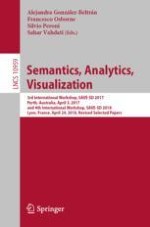2018 | Buch
Semantics, Analytics, Visualization
3rd International Workshop, SAVE-SD 2017, Perth, Australia, April 3, 2017, and 4th International Workshop, SAVE-SD 2018, Lyon, France, April 24, 2018, Revised Selected Papers
herausgegeben von: Alejandra González-Beltrán, Francesco Osborne, Dr. Silvio Peroni, Sahar Vahdati
Verlag: Springer International Publishing
Buchreihe : Lecture Notes in Computer Science
